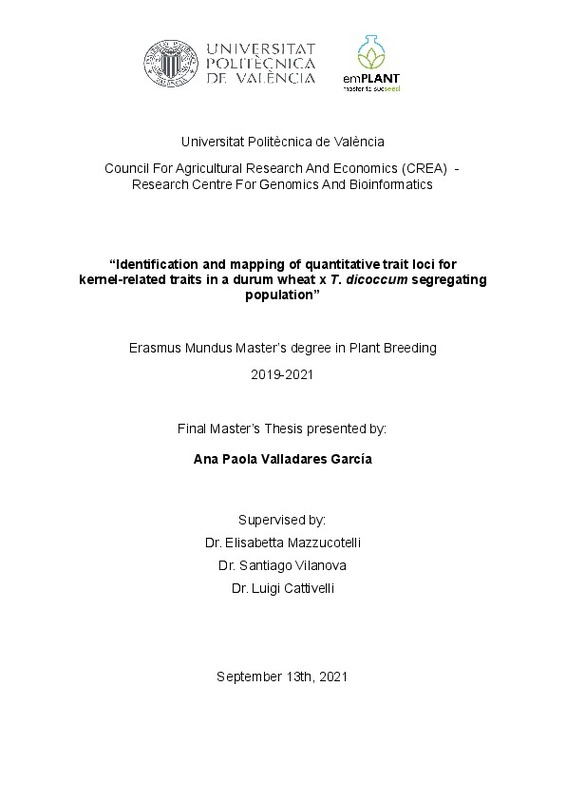JavaScript is disabled for your browser. Some features of this site may not work without it.
Buscar en RiuNet
Listar
Mi cuenta
Estadísticas
Ayuda RiuNet
Admin. UPV
Identification and mapping of quantitative trait loci for kernel-related traits in in a durum wheat x T. dicoccum segregating population
Mostrar el registro sencillo del ítem
Ficheros en el ítem
| dc.contributor.advisor | Mazzucotell, Elisabetta
|
es_ES |
| dc.contributor.advisor | Vilanova Navarro, Santiago
|
es_ES |
| dc.contributor.advisor | Cattivelli, Luigi
|
es_ES |
| dc.contributor.author | Valladares García, Ana Paola
|
es_ES |
| dc.date.accessioned | 2021-10-13T11:39:26Z | |
| dc.date.available | 2021-10-13T11:39:26Z | |
| dc.date.created | 2021-09-22 | |
| dc.date.issued | 2021-10-13 | es_ES |
| dc.identifier.uri | http://hdl.handle.net/10251/174573 | |
| dc.description.abstract | [ES] El trigo duro (Triticum turgidum ssp. durum), materia prima de la pasta, es el décimo cereal más importante a nivel mundial. A fin de satisfacer su futura demanda a pesar del cambio climático, es necesario entender la base genética de uno de los principales componentes de su rendimiento, el peso del grano (en inglés TKW). Una estrategia para alcanzar dicho objetivo, es el estudio de nuevos recursos genéticos, como el farro (T. turgidum ssp. dicoccum), con el fin de descubrir alelos favorables que controlan los caracteres morfológicos del grano, los cuales tienen un rol determinante sobre el peso del grano. Con dicho contexto, el presente estudio tuvo como objetivo explorar la red genética responsable de los factores del tamaño (longitud, ancho, perímetro y área) y forma (relación ancho-longitud y coeficiente de forma) del grano y sus relaciones con el peso del grano y la fecha de espigado. Se realizó un mapeo de locus de rasgo cuantitativo (QTL) en una población segregante de 110 líneas endogámicas recombinantes, derivadas de la cruza entre T. dicoccum accessión MG5323 x T. durum variedad Latino, y cultivada en 4 ambientes. Un total de 20 QTL fueron detectados estables entre los ambientes y agrupados en 6 clusters en los cromosomas 2B, 3A, 3B, 4B, 6B y 7A. Entre ellos, destaca el cluster localizado en el cromosoma 4B y relacionado con los caracteres del tamaño del grano y el peso del grano, cuyo alelo favorable fue donado por el parental T. dicoccum. Las posiciones físicas de los clusters, definidas por la proyección de los marcadores en el genoma de referencia, coincidieron con las posiciones de genes ya descritos, por ejemplo, BIG GRAIN PROTEIN 1 en el cromosoma 4B. Dichos resultados proporcionan información genómica de T. dicoccum para facilitar su uso como donador de alelos favorables en el trigo, aplicados a la mejora de su rendimiento por medio de marcadores moleculares. | es_ES |
| dc.description.abstract | [EN] Durum wheat (Triticum turgidum ssp. durum), which constitutes the raw material of pasta, is the 10th most important cereal worldwide. A key goal in order to meet its upcoming demand while coping with climate change, is to understand the genetic control behind thousand kernel weight (TKW), a major component of grain-yield. A strategy to achieve this is to explore new genetic resources as domesticated emmer (T. turgidum ssp. dicoccum) to discover favorable alleles that affect kernel morphological factors, which have a determining role on TKW. Therefore, the present study aimed to explore the genetic network responsible for kernel size components (length, width, perimeter and area) and kernel shape (width-length ratio and form coefficient) and their relationships with kernel weight and heading date. QTL mapping was performed on a segregating population of 110 recombinant inbred lines, derived from a cross between T. dicoccum accession MG5323 x T. durum cv. Latino, evaluated in 4 different environments. A total of 20 QTL were found environmentally stable and further grouped in 6 clusters on chromosomes 2B, 3A, 3B, 4B, 6B and 7A. Among them, a QTL cluster on 4B chromosome was associated with kernel size traits and TKW, where the parental MG5323 contributed the favorable allele, highlighting its potential to improve durum wheat germplasm. Further, the physical positions of the clusters, defined by the projection on the T. durum reference genome, overlapped with already known genes, such as BIG GRAIN PROTEIN 1 on chromosome 4B. These results might provide genome-based guidance for the efficient exploitation of T. dicoccum variability in wheat, possibly through yield-related molecular markers. | es_ES |
| dc.format.extent | 68 | es_ES |
| dc.language | Inglés | es_ES |
| dc.publisher | Universitat Politècnica de València | es_ES |
| dc.rights | Reserva de todos los derechos | es_ES |
| dc.subject | Trigo duro | es_ES |
| dc.subject | Triticum dicoccum | es_ES |
| dc.subject | Locus de rasgo cuantitativo | es_ES |
| dc.subject | Tamaño y forma de grano | es_ES |
| dc.subject | Peso del grano | es_ES |
| dc.subject | Durum wheat | es_ES |
| dc.subject | Quantitative Trait Locus | es_ES |
| dc.subject | Kernel size and shape | es_ES |
| dc.subject | Kernel weight | es_ES |
| dc.subject.classification | GENETICA | es_ES |
| dc.subject.other | Máster Universitario Erasmus Mundus en Mejora Genética Vegetal / Erasmus Mundus Master Programme in Plant Breeding - emPLANT-Màster Universitari Erasmus Mundus en Millora Genètica Vegetal / Erasmus Mundus Master Programme in Plant Breeding - emPLANT | es_ES |
| dc.title | Identification and mapping of quantitative trait loci for kernel-related traits in in a durum wheat x T. dicoccum segregating population | es_ES |
| dc.type | Tesis de máster | es_ES |
| dc.rights.accessRights | Abierto | es_ES |
| dc.contributor.affiliation | Universitat Politècnica de València. Departamento de Biotecnología - Departament de Biotecnologia | es_ES |
| dc.description.bibliographicCitation | Valladares García, AP. (2021). Identification and mapping of quantitative trait loci for kernel-related traits in in a durum wheat x T. dicoccum segregating population. Universitat Politècnica de València. http://hdl.handle.net/10251/174573 | es_ES |
| dc.description.accrualMethod | TFGM | es_ES |
| dc.relation.pasarela | TFGM\143950 | es_ES |






